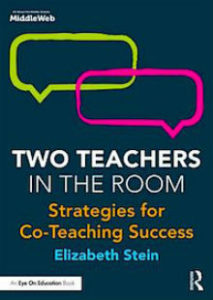Making Equity Visible in Inclusive Classrooms
A MiddleWeb Blog

Every minute of time we have with our students is so valuable. We must make the most of our instructional decisions so they provide maximum benefit for our classes as a whole and also support the individual strengths and areas of need for our students with disabilities.
So how do we balance this very challenging set of priorities without the William Tell Overture racing through our minds and sending us into a possible tizzy? It’s really quite simple. Just focus on equity.
Equity is the answer! And with two teachers in the room, practices that are both equitable and inclusive can sustain the flow of meaningful instructional experiences for everyone.
Keep in mind, I am not sharing a systematic recipe here. The process of equitable instruction is not, not, not a checklist. The process unfolds as we embed some key strategies and structures that align specifically with our co-teaching strengths and our students’ abilities.
It is all about connecting with your students – and with your co-teacher – to allow for a more peaceful tune (how about Pachabel’s Canon in D Major) to guide your co-teaching moves.
OK! Are you ready to make equity a mindful and visible process in your inclusive classroom? Great! I knew you were coming along for the ride with me…let’s do this!
4 Tips for Visible Equity
1. Participation: Who’s doing most of the talking in your room? If it’s you, take a step back and find the balance to include your co-teacher and every student in the class. Check out these Teaching Channel tips for 10 powerful ways to create the space for all students and co-teachers to exercise their thinking and sharing during any lesson.

2. Design for Individual Thinkers: OK, so we are planning lessons for whole class learning, but we must also consider students’ individual strengths and needs. Consider small group instruction as a solution to co-creating more manageable, personalized, empowering learning.
Remember my past blog post on small group instruction as a solution for inclusive practices? Read it here—check out the resources and make them your own with your co-teacher and students. Also, check out this post about Awakening the Thinkers in Your Classroom for more specific strategies and ideas.
3. Embed Universal Design for Learning: The UDL guidelines and principles pave the way for co-teachers to consider their roles in supporting executive function skills along with guiding each student to become a strategic, resourceful learner. Lessons are proactively differentiated so each learner has the opportunity to take charge of his or her learning process. Check out this blog post to learn more about how to adopt a UDL mindset in guiding student achievement—equitably!
4. Keep YOUR passion for teaching alive—times two! Let’s face it: students know how you feel about each lesson and each other. And most important, they perceive how much you care about their learning. Your passion (times two!) can really spark students to take risks, ask questions, and see the space they’re in as a safe haven for them to do whatever it takes to connect with the learning in your room. Are you in need of a passion boost? Try one or more of the following to revive the energy your students need you to have.
• Organize: Who doesn’t feel recharged when organization is in place? Go for it! Perhaps you need to clean your desk, decorate your room, update a bulletin board with fresh ideas. Also, check your student data files. If they’re not as organized as you hoped, do not back track—that is just overwhelming. Start now in leading through the rest of the year by collecting data in ways that guide you to use student work and work samples to inform your instruction. If you’re looking to go digital, check out these apps. For example, GoFormative.
• Embrace Change: Be open to new ideas. There is nothing in life that stays still—life is all about change. Connect new ideas with your good old trusted ways to expand what you are doing and to ease your way into meaningful change. Take the next step and discuss your ideas for change with your co-teacher and achieve it together!
• Prioritize: Keep students at the center. Keep ongoing communication open with your co-teacher. And take time for yourself to do what you enjoy outside of the school day. Balance your many tasks—becoming confident that each decision you make is guiding every learner in your room to become the best he or she can be.
It’s All about the Students
Making equity visible is all about creating the spaces for students to meaningfully and actively participate. Anyone visiting the classroom will see and feel the passion for learning that unfolds through thoughtful and intentional planning. Equity is visible and palpable when it is obvious that the co-teachers make time for their combined expertise to spark the learning process for every learner.
Let’s continue the conversation…
What does equity look like to you? How do you know when co-teachers are designing with a strong focus on equity?
________________________________________































